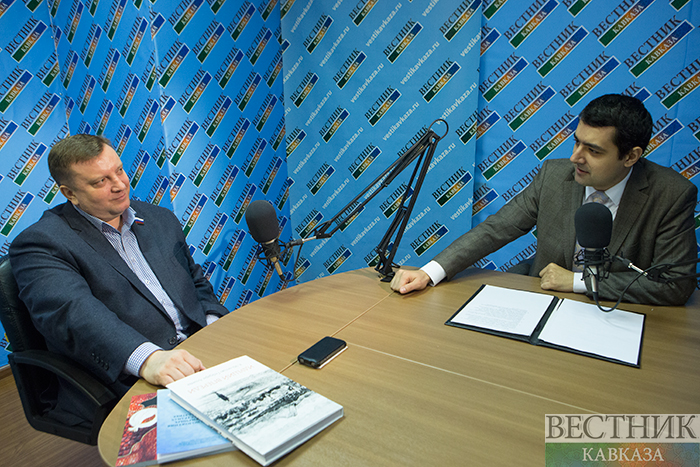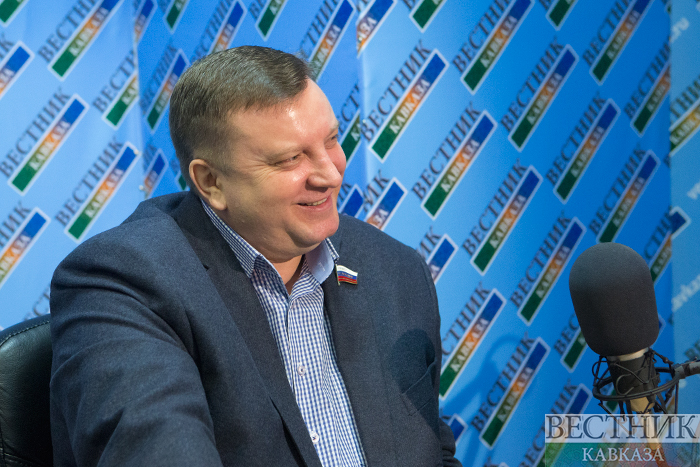Tribune’s guest is a member of the Federation Council Committee on Defense and Security. Alexei Vladimirovich represents the Tambov region in the upper house of the Russian parliament.
- We at the Tribune program have a traditional heading ‘From Kamchatka Territory to the Kaliningrad Region.’ We ask our guests to tell us about the regions that they represent in the Federation Council. How can you assess the tourism capacity of the Tambov region?
- The Tambov region was formed as a region a long time ago, and for its pioneering entity was one of the leading provinces in the tsarist times. Tambov city itself, as the capital of our region, was founded in 1636 by governor Roman Boborykin. The city of Tambov was created as a fortress on the southern borders of the then quite young Russian state, primarily for protection from the raids of the Crimean Tatars and the Nogai khans from the side of the wild pitch. You know that in the 17th century the policy of the Russian state was to expand the territories, moving the state boundaries as far as possible from Moscow and to exclude the interdiction of such raids, because it was quite a serious problem for the state at that time. Enclaves remained from the Golden Horde from the time of Genghis Khan’s raids; actually one of them was the campaign of Batu Khan, a grandson of Genghis Khan, which incidentally took place quite close to the geographical point where Tambov city is today. There is a beautiful legend about him crossing the river. On the other side a territory populated by Russian Slavic tribes began, and one of his wives, a native of this area, asked him not to go to these lands. For this, he hit her with a whip, and then cried out in pain, as allegedly a mutual son of Batu and that woman stabbed him in the leg, which was standing in the stirrup. As a result, the boy and his mother were buried alive under a mound. We have quite a lot, more than 3000 mounds in the region, well, since the time of the Scythians, and since the time of the nomadic movements and the Tatar tribes, and the Mordovian tribes. Because the boundary of the wild pitch at that time was like one of the main roads or one of the branches of the Great Silk Road, that is, of quite large migration flows.
From the 17th century, our kings, pushing the boundaries to the south and south-west, and east, were engaged in the establishment of border lines. And the Ryazan Cossacks, the Cossacks of the Don, the monastery peasants created a base, in general, the inhabitants of which became the future inhabitants of the province of Tambov and the Tambov region today. There was then a fortress around the city of Tambov, settlements were formed; they still exist. All of them have military titles – Regimental, Archers, Gunners. That is, the entire population was mainly servicemen.
Ahead of the Great Patriotic War, after the most terrible purges of civilians, Tambov province included very large areas of the Lipetsk region, the Ryazan, Saratov, Penza, Nizhny Novgorod, Vladimir provinces, the territories of the republic of Mordovia today were reduced. This is a particular genotype, laid back then, which allowed Tambov to become a city of hard workers, and a city of warriors. More than 450 thousand people from the Tambov region left for the war. Accordingly, more than 250 thousand did not return. On the number of residents who are heroes of the Soviet Union, full chevaliers, the inhabitants of the Tambov region are in fifth place in the Soviet Union. The first woman to be awarded the title of Hero of the Soviet Union during World War II was our compatriot Zoya Kosmodemyanskaya.
I was born in my ancestral village, which is just 5 km away from Zoya and Shura Kosmodemyansky’s home village of Osino-Guy. Since my childhood I have heard the stories about them. Shura also became a Hero of the Soviet Union. And their grandfather, who served as a priest in the temple of Osino-Guy, was shot during the clearances in 1937. Just imagine what kind of people live in Tambov who can work hard and stand up for their country?
After the war, Tambov was a research and production center. It was awarded the Order of the Red Banner of Labor for its merits in the development of chemical engineering. The region today is quite a dynamically developing region, which is a symbiosis of production capacity, primarily in the defense direction and the scientific cluster. And today we are making great strides in the development of agriculture. Tambov is the birthplace of the Agricultural Fair. We revived the so-called Pokrovsky Fair. It was one of the largest agricultural fairs in Tsarist Russia, which, of course, for obvious reasons, ceased to exist in 1917. By reviving here this fair on the Day of Protection of the Most Holy Mother of God, on October 14th, it is one of the largest major Orthodox holidays, and of all the Christian holidays, entrepreneurs, traders, people that produce all kinds of items of folk crafts, creative teams from around the world, first of all our partners from the partner states of the twin cities, and everyone willing gathered and gathers now as well. And if in the years of Tsarist Russia it was of great value for its agricultural show, well, it can be compared for example with Die grüne woche (Green Week) in Berlin, now we also return to our producers quietly.

In addition, there are areas that are associated with the development of Orthodoxy. There is the so-called Mammoth Desert in the Sosnovsky district, where there was a phenomenon of the Virgin. At the moment, there is a remarkable monastery, which, due to the efforts of the Russian Orthodox Church, has been restored. On the eve of the new year, the head of the Administration of the Tambov region, Alexander Valerievich Nikitin, handed over a wonderful convent in Satinka to the Russian Orthodox Church. Before the revolution it was almost the largest convent in Russia. The lives of many of our saints are also associated with the name of this monastery, including Sergius of Radonezh, Saint Pitirim and many others.
Tambov is a symbiosis of new buildings and buildings of the 18th-19th centuries in the modern style. World War II didn’t touch the city, and a lot of buildings were preserved.
- Are these stone buildings?
- These are stone buildings with interesting facades. There are many Orthodox churches in Tambov. If pre-revolutionary Voronezh, which at that time was already much bigger than Tambov, had one and a half times fewer churches than Tambov, then today, of course, we see Orthodox churches on the face of our Tambov, and it must be said that 83% of parents, in the framework of the study of foundations of religious culture in elementary school today, are choosing Orthodoxy. 92% are the titular nation – Orthodox people: Russians, Ukrainians, Belarusians – but Russians are the majority. Of course, we have more than 60 nationalities, and all of us cooperate and live in the same style. According to the results, for several consecutive years Tambov has taken the title of 'Safest City' in the framework of the Interior Ministry's inspections, a survey of citizens themselves and a study of social opinion.
- Is the tourism infrastructure developed?
- There are historic sites and a large number of museums. We have the regional local history museum, the museum and exhibition center, primarily dedicated to the history of the Great Patriotic War. There is the Museum of Military Medicine, one of the few in the country, with a monument to military doctors. There is a huge number of monuments to various figures. For example, there is still a monument to Mikhail Lermontov, who wrote 'The Tambov Treasurer's Wife'. Remember the beginning: "Tambov is not always marked by the general circle on the map ...". Precisely the monument, installed in May of 1941 has remained. At the time, in the country, in the Soviet Union, there were three monuments to Lermontov. And this great Russian poet, yes, who dedicated a lot of time to the Caucasus, is chronicled in various poems today, including in the Caucasus. He was born in the Penza region, lived with his grandmother in Tarkhany, but passed through our city very often.
In the times of Gavriil Derzhavin, one of the first Russian governor-poets, innovators in their essence, we created a number of objects. In tsarist Russia, the first three newspapers were the Moscow Provincial Gazette, the Saint Petersburg Provincial Gazette, and the Tambov Provincial Gazette was the third newspaper. Tambov State University released a collection of Tambov Provincial Gazettes from the times of Derzhavin – these are copies of those newspapers that have been issued by Derzhavin. Under Derzhavin, district education was created, in other words, those children, who did not have an opportunity to study because of the poverty of their parents, were taught on a mandatory basis. This man understood that children should be raised as hard workers, should not be raised as ballast, who are incapable of determining their own fate later, and unable to integrate into the social community as citizens.
Derzhavin also started the process of rearing horses. The Tambov region was one of the centers of horse breeding. Today this process is understandably reduced, but nevertheless there are buildings and gatherings of breeders, thanks to whose efforts two horse farms were preserved on the territory of the Tambov region, and we will undertake active efforts to develop them. Today it is quite important. What I want to say: we have one of the oldest hippodromes in Russia, too, along with the hippodrome here in Moscow, at Begovaya, and St. Petersburg's hippodrome. At one time there was an approach, and in the country, there were the Tambov horse farms, with tdeernupport of the hippodrome, which bred the Orel Trotter. It's our Russian Akhal-Teke horse.
As for ecological tourism, there is, of course, hunting. However, the last bear here was killed in 1957. Thanks to the efforts undertaken in the framework of environmental protection and environmental management, populations of moose, wild boar, roe deer and so on are reviving today.
- What can you say about hotels and transport?
- The tourism infrastructure is created fully, we have hotels, and there is the possibility of car rental to move around the region. Actions of the police in providing security are well developed. And medical facilities, facilities in the framework of the main tourist routes, including the territories of conservation areas, because many people prefer travelling by kayak.







